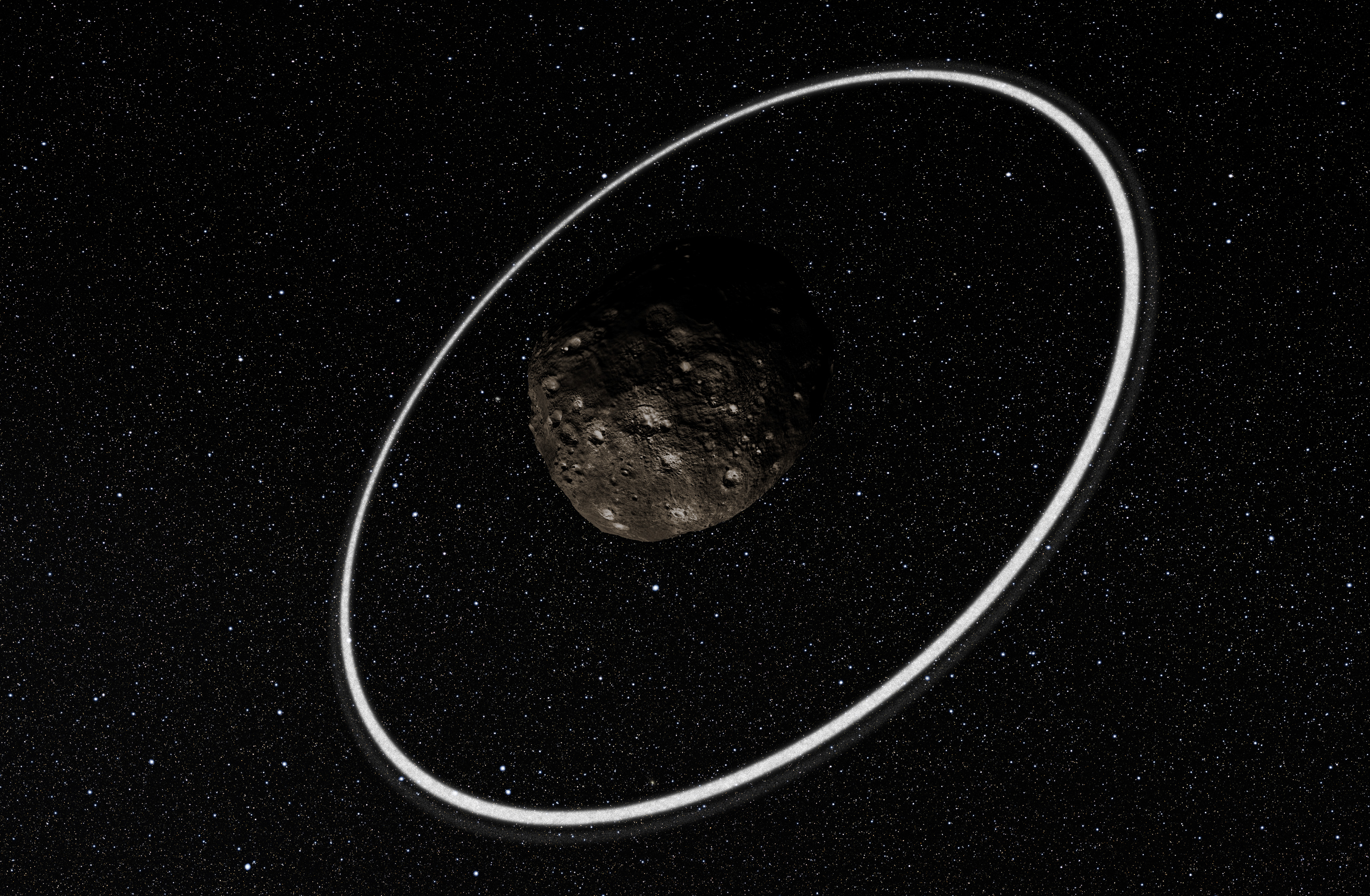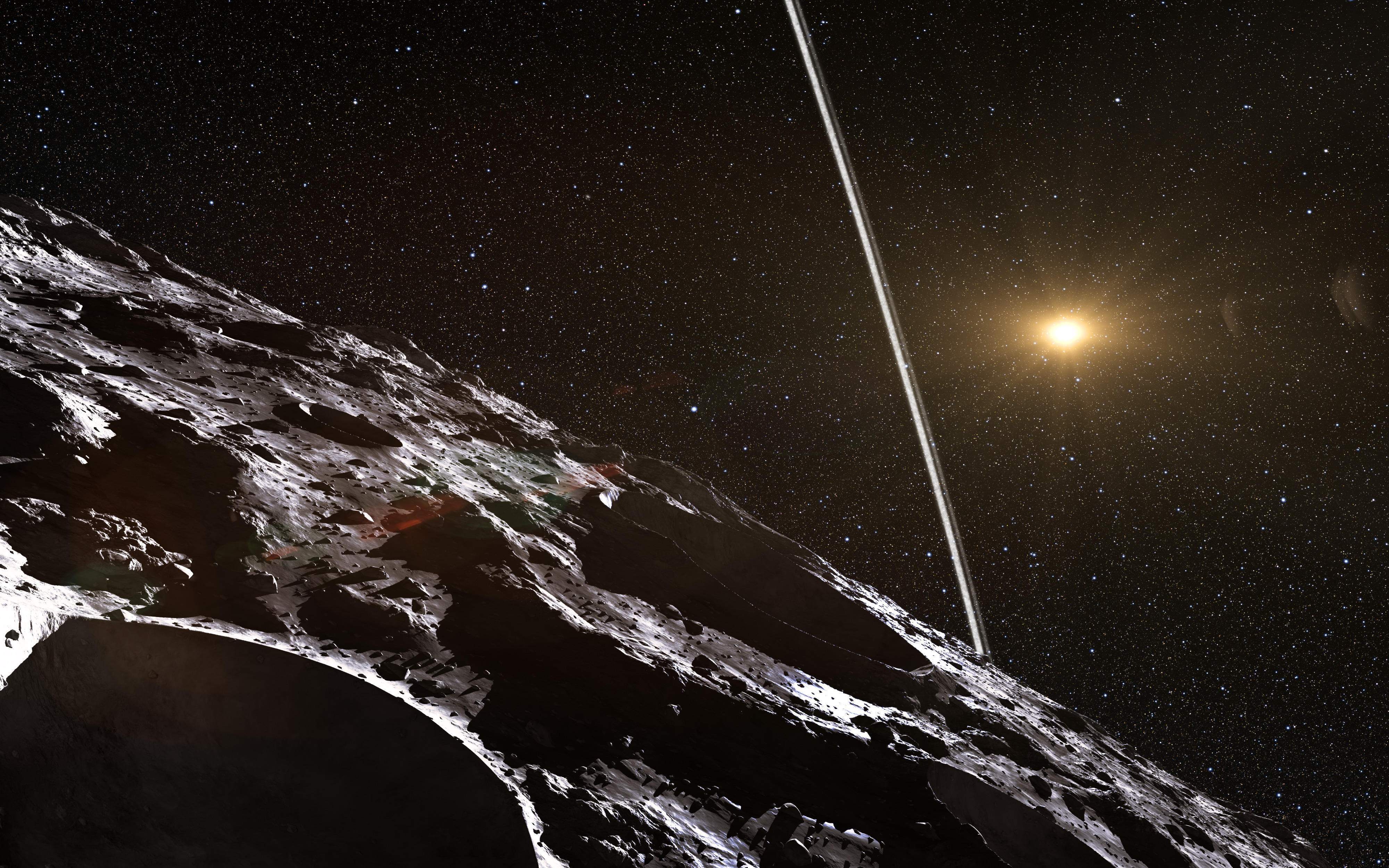Tiny Ringed Object Beyond Saturn May Reveal Secrets About Giant Planets

Just past Saturn lies a tiny, asteroid-like object with rings of its own. New observations of the object, known as Chariklo, have revealed new insights about the unusual rings and may help solve the mystery of their formation.
When it was spotted in 2013, Chariklo was the first tiny solar system object found to have rings, though now a handful of others have been discovered with these features, according to a research paper describing the new observations.
"Until 2013, rings were only known around giant planets," the authors wrote in the paper. "This discovery was thus surprising, and is key to better understanding the planetary rings, since [small-object ring systems] now appear to be more common than previously thought." [Asteroid Chariklo Has Rings: Images of a Space Rock Oddity (Gallery)]
Hunting rings
For centuries, Saturn dominated as the only solar system body known to boast rings. In 1979, the Voyager 1 spacecraft revealed that Jupiter also hosts a set of rings. Uranus and Neptune also have thin rings of their own, spotted in 1977 and 1989, respectively, though none of those rings spread as far from their planet as the more notable rings of their famously ringed sibling. Whereas Saturn's rings are dominated by ice, dust fills the rings of Neptune and Jupiter, making them dimmer and harder to spot; Uranus' ringsare a mixture of ice and dark material that kept them hidden from view. But all of these worlds are massive gas and ice giants that are far larger than the terrestrial planets and the smaller rocks (like asteroids and comets) that orbit the sun.
Chariklo is classified as a centaur, or one of the small objects orbiting between Neptune and Jupiter. Though centaurs can harbor characteristics of either asteroids or comets (or both), Chariklo bears a stronger resemblance to rocks than ice. The asteroid-like object is only about 148 miles (240 kilometers) across, and its rings are similarly scaled down. The rings' small width and their orientation as seen from Earth, combined with their distance from Chariklo, can make them challenging to spot from Earth, the researchers said.
"If you are located on Chariklo's equator, you won't see [the rings] because they are very thin, and you will see them edge-on," Diane Berard, a researcher at the Paris Observatory, told Space.com by email. Berard is the lead author of the new paper, which was published in September 2017 in The Astronomical Journal.
"On the contrary, if you are located on the poles, you will see a bright strip of a width about the diameter of the full moon," Berard said.
Get the Space.com Newsletter
Breaking space news, the latest updates on rocket launches, skywatching events and more!
To identify and study the rings, astronomers rely on distant stars. As Chariklo passes in front of, or occults, a star, its rings block out light from the faraway sun. Before Chariklo obstructs the starlight, its rings create a flickering effect that differs based on their size and orientation. (In fact, that's how the rings of Uranus were first discovered.) Then, the body of Chariklo also can be studied as it occults the star.
"For the past twenty years, our team [has been] observing stellar occultations," Berard said. "We thus developed a large network of professional and amateur observers that we can contact in order to observe an occultation."
Together, this team observed Chariklo 12 times between 2014 and 2016, using telescopes around the world. They confirmed that the centaur has two thin, circular rings. The first, known as C1R, stretches from 3 to 4.6 miles (5 to 7.5 kilometers) in width, with sharp inner and outer edges. The second, C2R, is somewhere between 0.06 and 0.62 miles (0.1 and 1 km) wide. The two rings are separated by about 9 miles (15 km).
The original observations of Chariklo suggested that the material observed around the object could be a diffuse shell of material spewing from the centaur itself. Berard and her colleagues not only confirmed that these features are rings but found no signs of massive jets releasing material.
The team also searched for signs of fainter ring material and potential moons around Chariklo, since gravity from a moon could be responsible for keeping the inner ring sharp. However, they found no sign of a satellite over 1.2 miles (2 km) wide within an area eight times Chariklo's ring size. [The Strangest Asteroids in the Solar System]

A tiny mystery
Small ring systems are more abundant in the solar system than researchers previously thought, according to the paper. Another centaur, Chiron, is suspected to host its own set of rings, though Berard said their existence has not yet been confirmed. Farther out, the dwarf planet Haumea has a much larger set of rings.
Despite being far smaller than the rings around the giant planets, Chariklo's disk doesn't seem to be significantly different from those ring systems, Berard said.
"They seem to have the same characteristics [as the] alpha, beta or epsilon [rings] of Uranus — eccentricity, sharp edges, edges denser than the center," she said. (Eccentricity means the degree to which the rings' orbits are elongated, rather than perfectly circular.) But, she added, the researchers need to do more observations to confirm that hypothesis.
Those observations will improve with the help of the European Space Agency's Gaia spacecraft. As it charts over a billion stars, the spacecraft will improve the accuracy of known stellar locations and movements, making it easier to predict when Chariklo will occult another star. Gaia has been in orbit since 2014 on a five-year mission and has already released its first round of data.
Predicting when Chariklo will pass in front of a star is the biggest challenge, Berard said. In 2014, an error in predicting the stars' locations resulted in a lot of missed opportunities, she said.
"Gaia will increase by a factor of 20 the accuracy of the predictions," she said. "[Unless] the clouds are out, we would not miss an occultation anymore."
Observing and studying the rings may improve scientists' understanding of where these rings come from. Right now, there are numerous possibilities. According to Berard, they could have formed from the destruction of an early moonlet. A passing object could have slammed into Chariklo and created this moon, a smaller-scale version of how Earth's own moon was created. Or the centaur's gravity could have gathered the rubble as it swept through space.
"The only certainty is that they [Chariklo's rings] have been around at least for the past four years — since the discovery in June 2013 — and are less than 4.5 billion years [old]," Berard said, meaning they must be younger than the solar system itself.
Follow Nola Taylor Redd at @NolaTRedd, Facebook, or Google+. Follow us at @Spacedotcom, Facebook or Google+. Originally published on Space.com.
Join our Space Forums to keep talking space on the latest missions, night sky and more! And if you have a news tip, correction or comment, let us know at: community@space.com.

Nola Taylor Tillman is a contributing writer for Space.com. She loves all things space and astronomy-related, and enjoys the opportunity to learn more. She has a Bachelor’s degree in English and Astrophysics from Agnes Scott college and served as an intern at Sky & Telescope magazine. In her free time, she homeschools her four children. Follow her on Twitter at @NolaTRedd









